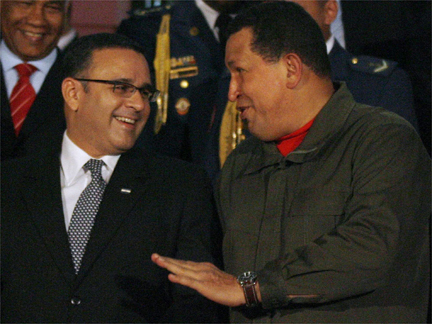 The country’s debt has been repeatedly downgraded as President Mauricio Funes has increased government spending.
The country’s debt has been repeatedly downgraded as President Mauricio Funes has increased government spending.The same Brazilian advertising hotshot who worked his magic to get a left-winger elected president of El Salvador in 2009 is running the presidential campaign of national socialist Ollanta Humala in Peru. If João Santana’s expertise translates into a Humala victory, Peruvians had better hope that the similarities end there.
Mr. Santana’s successful Salvadoran client, Mauricio Funes of the FMLN party, has been a disaster for the once-thriving Salvadoran economy. One example: The United Nations’ Economic Commission on Latin America and the Caribbean reported earlier this month that while “the region’s FDI inflows were 40% higher than in 2009,” El Salvador didn’t benefit. “In Central America, foreign investment flows to all countries grew, except in the case of El Salvador.” It experienced a 79% decline.
Not so long ago the prospect of El Salvador at the back of the competitiveness pack in the region would have seemed impossible. Even before the 1992 peace accords were signed, the country began a modernization that lasted more than a decade. The free market reforms were unique in Central America and nearly unequaled in the wider region. Only Chile’s economic liberalization of the 1970s and 1980s was comparable.
The results were impressive, particularly for a country with a largely uneducated work force. From 1989 to 2008 El Salvador had the highest export growth in the region (an increase of some 800%), and per capita growth in gross domestic product was among the fastest in the region. This was led for the first time by strong performance in the industrial sector instead of in more traditional agriculture. By 2006, the poverty rate had fallen to 31% of the population from 60% in 1991.
Then the wheels came off. The Arena Party, which had led reform, managed to get its fourth consecutive president, Tony Saca, elected in 2004. Unhappily he showed much less interest in leading on the development front than his predecessors.
A good example was his refusal to grant operating permits to Pacific Rim Mining Corporation for its El Dorado gold mine in one of the poorest parts of the country. The mine was blocked without an official explanation, though Mr. Saca’s team never disputed the company’s claim that it had met or exceeded all of Salvador’s environmental benchmarks. Thousands of jobs were forfeited, investors lost millions of dollars and El Salvador’s investment reputation got a black eye.
Salvadorans were already disillusioned when candidate Funes came on the scene to offer an alternative. He ran as a moderate leftist who pledged to put a stop to the endemic corruption that had blossomed under Mr. Saca, and to make all Salvadorans better off. So much for campaign promises. Since Mr. Funes came into office, Salvador’s debt position has been deteriorating rapidly. In December 2008, the debt-to-GDP ratio was just under 36%. By December 2010 it was more than 51%.
The way that borrowing is being spent is even more worrisome. According to the government’s first quarter 2011 fiscal report, there has been a 17.5% year-over-year increase in current expenses. This includes a 15.5% jump in the public-sector wage bill, 21% growth in government expenditures of goods and services, and a 48% increase in transfer payments—mostly subsidies. Investment is down 3.6%, while the fiscal deficit has expanded 28.6%.
The rating agencies don’t like what they see. During the Funes presidency, Moody’s has twice downgraded the country’s debt, and Standard & Poor’s has issued one downgrade.
When Fitch Ratings warned El Salvador last fall to improve its investment climate or risk a downgrade, Mr. Funes was cavalier. El Salvador’s newspaper Diario de Hoy quoted him saying that if the World Bank, the IMF and the Inter-American Development Bank didn’t have confidence in the country, they wouldn’t keep extending credit. He obviously never has heard of Greece.
The U.S. Agency for International Development is also plowing ahead in El Salvador with what U.S. AID administrator Rajiv Shah has called President Obama’s “new partnership for growth.”
The problem is not only reckless spending but also hostility toward business. The Heritage Foundation/Wall Street Journal Index of Economic Freedom, which once ranked El Salvador as the ninth freest economy in the world (2000), now places it at 39. A good part of the decline occurred under Mr. Saca (losing 17 places in three years) but it has continued under Mr. Funes, who also refuses to allow the Pacific Rim mine to operate.
El Salvador now has no active mining concessions. But that loss of investment and jobs has not satisfied the party base of the FMLN. They complain loudly that Mr. Funes has yet to completely quash Salvadoran capitalism.
No comments:
Post a Comment